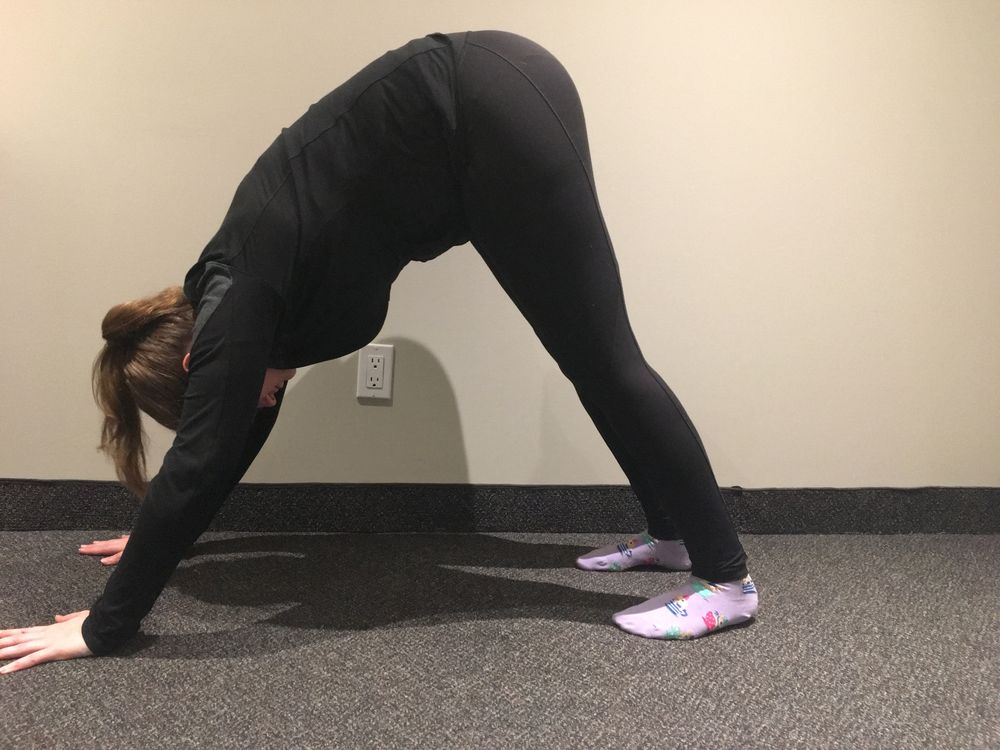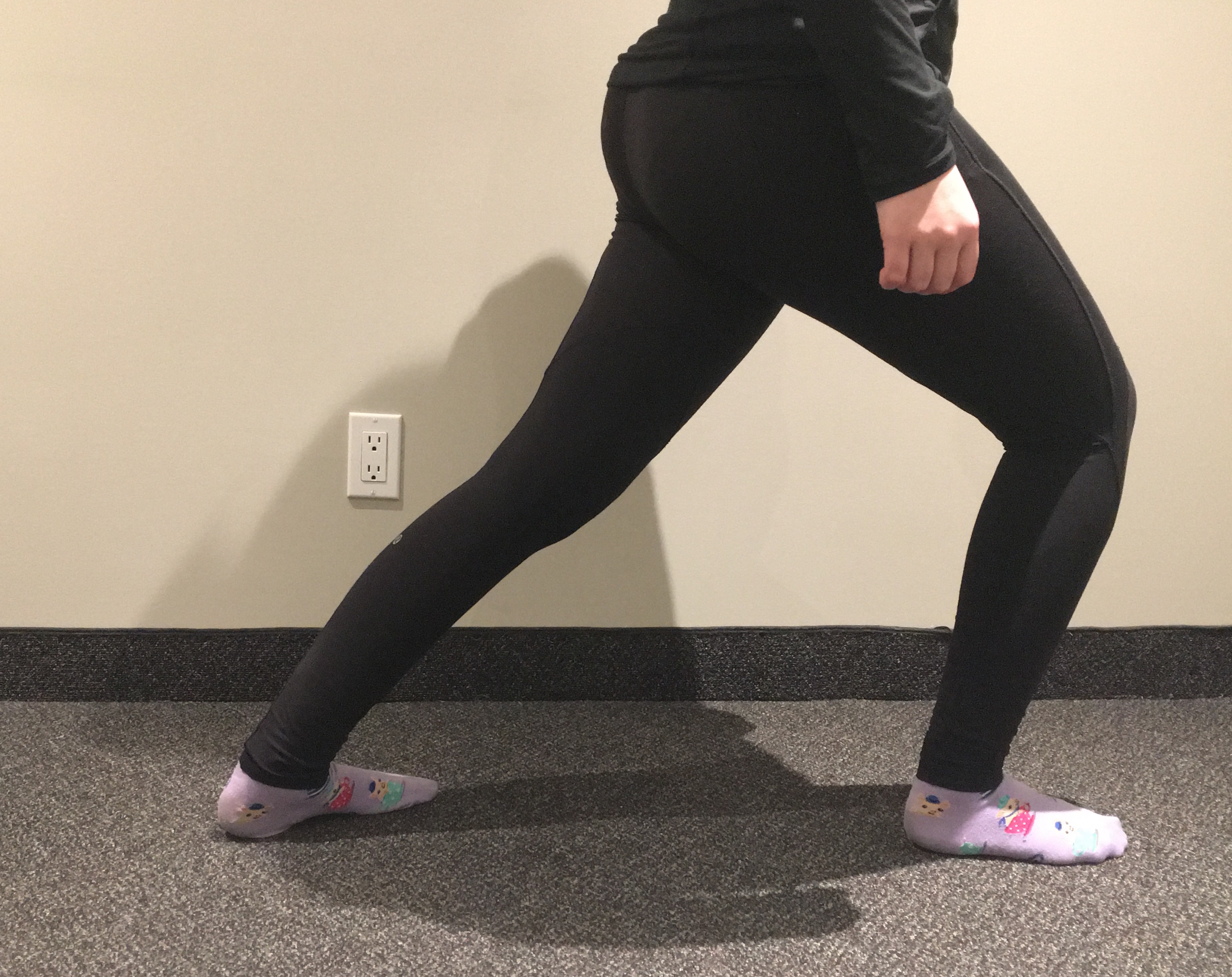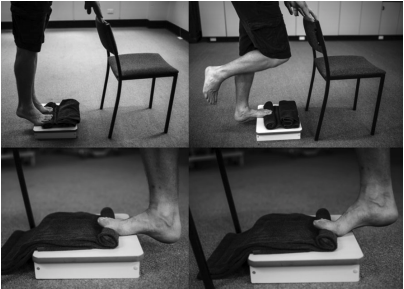1. Calf strength – Gastrocs
A surprise to some – your calf has more than one muscle in it! And strengthening those muscles will actually help improve your plantar fasciitis, and reduce your pain.
My favourite go-to exercise for calf strengthening targets your gastrocs: heel raises!
Stand with your feet apart (the closer together, the more difficult to keep your balance).
Keeping the balls of your feet on the floor and your knees straight, slowly raise your heels off the floor. Hold for a couple seconds, then slowly lower them back down to the floor. If this hurts, don’t lift your heels so far quite yet.
Then, in the wise words of Bo Burnham: ‘Repeat Stuff!’
Start with 10 calf raises a day. Then when that becomes too easy, try 15. Then 20. Then 25. Then 30. You get the idea. Once 20 gets easy, try doing some one legged too!
Even after your plantar fascia pain is gone, keep doing some heel raises once in a while! It’s a quick and easy way to keep your calves nice and strong! (Do them while you’re waiting in line, or brushing your teeth!)
2. Calf stretch
There are quite a few great calf stretches, but here are my top 3:
Downward dog

Seated calf stretch with resistance band

Lunging calf stretch

(Yes my socks have pigs wearing hats sitting in teacups. Move along.)
3. Arch control
This is a simple exercise you can do at home with just a penny (or a nickel, dime etc) and a pen. You can check out this blog for a great video on how to do it.
To begin, stand comfortably on a flat surface in your bare feet, with your toes relaxed.
Under the ball of your foot, just below the big toe joint, place the penny.
Then slide part of your pen under the arch of your foot, right in the centre of your arch. The rest of the pen should be sticking out from the inside of your foot.
Now comes the tricky part. Flex your arch muscles. You’ll know you’re doing it correctly when you feel your foot pressing onto the penny, but not onto the pen.
Don’t cheat by using your toes to help you – keep those little piggies relaxed.
Strengthening your arch muscles helps your ankle from pronating inward, and increasing the strength in your foot. What does this mean for your plantar fasciitis? Pain relief!
4. Orthosleeve
A compression foot sleeve can help support your foot, and relieve your plantar fascia pain. Orthosleeve offers a compression foot sleeve – the FS6 – with six zones of graduated compression. This helps support your arches, achilles, take the strain off your plantar, and increase blood flow throughout your foot. It comes in a box of two sleeves, and molds to your foot for a great fit.
Note: Wear the FS6 all day every day if you’d like. But do NOT wear it overnight to bed!
5. Calf Strength – SoleusRunnersWorld has a great calf strengthening exercise:
“Begin in a seated position with your feet flat on the floor. Your knees should be at a 90-degree angle and your thighs parallel to the floor. Place a weight evenly across your thigh or quadriceps muscles.
Roll up on the balls of your feet to your end range of motion. Pause for a moment. Slowly return to your starting position. Do a set with your toes pointed straight, toes pointed inward, and toes pointed outward. You may also perform this exercise one leg at a time to avoid compensation. Do several sets of 8-10 repetitions. Start with light weight and gradually increase over time as your body permits.”
It’s of note here that your soleus muscle is not what drives all your power from your calf. While your gastrocs unleash your sprinting power, your soleus makes sure enough blood gets through your legs. Both are very important!
6. Shoe inserts
Whether you opt for custom orthotics or some good ol’ Dr Scholl’s, shoe inserts can be an option for pain relief. Orthotics that have good arch support reduces pressure on your plantar, and cushions your heal.
Studies have shown that flat-footed athletes experience pain reduction with neutral cushioned shoes. Similar studies have been conducted that show pain reduction and improved quality of life for patients with plantar fasciitis who used foot orthoses for a year.
If you’re thinking about orthotics, seeing a podiatrist first is always recommended. But if you’re looking for a hopeful solution in the meantime, here are three (no particular order) of the most promising options the internet has to offer:
A. Dr Scholls
B. Amazon
C. Superfeet
7. Shockwave
Two different variants of receiving shockwave therapy currently exist: a low-frequency and a high-frequency. The high-frequency treatment is administered all at once, usually with an anesthesia. This treatment can be very painful. The low-frequency is performed through multiple visits with no anesthesia, and is reportedly notably less painful.
There are also two different types of shockwave, extracorporeal and focused. Both are intended to create a ‘microtrauma’ in the heel. Focused uses electromagnetic pulses to achieve this, whereas extracorporeal uses pneumatic technology (pressurized air).
Focused shockwave therapy (FSWT) was found to have more conclusive evidence in its success than extracorporeal (ESWT) in a 2017 study. That being said, not enough substantial evidence exists yet to prove the effectiveness of shockwave therapy. While it is very successful in some patients, it can have no effect in others. For this reason, it is not uncommon for insurance companies to not cover the treatment.
Talk to the different members of your health team about shockwave therapy to help determine if it’s a good choice for you.
8. Plantar Fascia Stretch
The great thing about this stretch is how incredibly simple it is.
Step one: Sit down!
Step two: Cross the sore foot over your other knee, so you can comfortably hold your sore foot with your hands.
Step three: Relax your foot!
Step Four: Gently push/pull your big toe up so that the ball of your foot gets a nice stretch. Hold that for about 5 seconds, then let your toe relax back to its normal position. Repeat this as often as you’d like, with minimal pain. Do not stretch your toe past its limits, or where it begins to cause more pain.
9. High Load
Remember the gastrocs strengthening exercise from the beginning of this post? Research has shown that you can modify that to place a higher load on the plantar fascia (by activating the Windlass Mechanism).
Remember the gastrocs strengthening exercise from the beginning of this post? Research has shown that you can modify that to place a higher load on the plantar fascia (by activating the Windlass Mechanism).
A study from 2014 by Rathlef et al showed that high-load strength training led to less pain and more function. In this case, the toes were elevated during heel raises.
10. Ball Roll – for relief
Grab a tennis ball, golf ball, lacrosse ball or something similar. Place the ball on the floor, and your arch on the ball. Roll the ball up and down around your arch, putting as much weight and pressure on the ball as you feel comfortable. It will help increase circulation, reduce tension and pain!
11. Heat
Choosing heat over ice is just a matter of preference. If you put a hot pack on and it feels better, then carry on! If you put it on and it doesn’t feel good, then stop! Try some ice instead.
12. Ice
Same as above for heat, but reverse. Do what feels good. Pretty simple, right?
13. Load Management
Load management can be difficult for a lot of people. What it means is a reduction in the amount you use that muscle/body part. If you’re a runner, you will be running less. If you’re a dancer, dance less. Stop wearing heels. If you stand in one place a lot at work, move around more, put your foot in different positions. Stop stressing your foot out! It needs a break, and not just for a day or two. Think weeks.
14. 519-895-2020
If you live in the Kitchener area (or feel like driving to Kitchener for treatment) call that number! You may recognize it – it’s ours. A great way to help relieve you of your plantar fasciitis pain is physiotherapy! Give us a call or book an appointment online at strivept.ca.
Questions? Comments? Cries of anguish? Brain-tingling curiosities? Let us know and leave a comment!
Cheers,
Chelsea Simo
